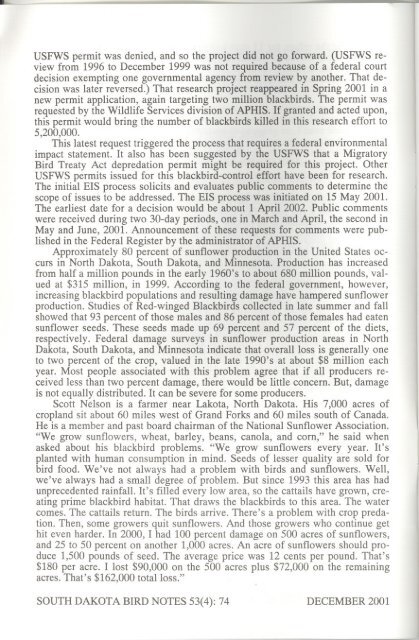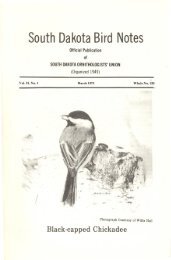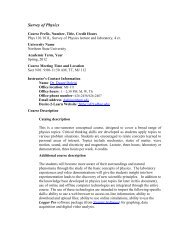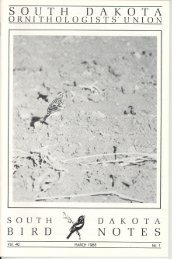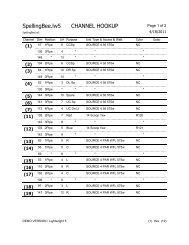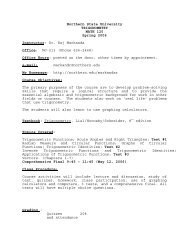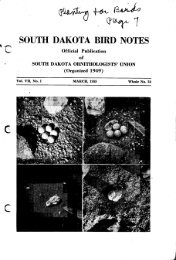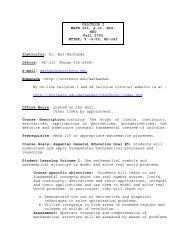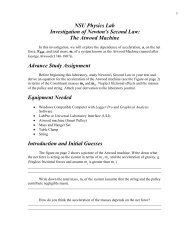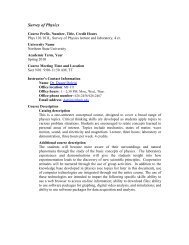........... ,.USFWS permit was denied, and so the project did not go forward. (USFWS reviewfrom 1996 to December 1999 was not required because of a federal courtdecision exempting one governmental agency from review by another. That decisionwas later reversed.) That research project reappeared in Spring <strong>2001</strong> in anew permit application, again targeting two million blackbirds. The permit wasrequested by the Wildlife Services division of APHIS. If granted and acted upon,this permit would bring the number of blackbirds killed in this research effort to5,200,000.This latest request triggered the process that requires a federal environmentalimpact statement. It also has been suggested by the USFWS that a MigratoryBird Treaty Act depredation permit might be required for this project. OtherUSFWS permits issued for this blackbird-control effort have been for research.The initial EIS process solicits and evaluates public comments to determine thescope of issues to be addressed. The EIS process was initiated on 15 May <strong>2001</strong>.The earliest date for a decision would be about 1 April 2002. Public commentswere received during two 30-day periods, one in March and April, the second inMay and June, <strong>2001</strong>. Announcement of these requests for comments were publishedin the Federal Register by the administrator of APHIS.Approximately 80 percent of sunflower production in the United <strong>State</strong>s occursin North Dakota, South Dakota, and Minnesota. Production has increasedfrom half a million pounds in the early 1960's to about 680 million pounds, valuedat $315 million, in 1999. According to the federal government, however,increasing blackbird populations and resulting damage have hampered sunflowerproduction. Studies of Red-winged Blackbirds collected in late summer and fallshowed that 93 percent of those males and 86 percent of those females had eatensunflower seeds. These seeds made up 69 percent and 57 percent of the diets,respectively. Federal damage surveys in sunflower production areas in NorthDakota, South Dakota, and Minnesota indicate that overall loss is generally oneto two percent of the crop, valued in the late 1990's at about $8 million eachyear. Most people associated with this problem agree that if all producers receivedless than two percent damage, there would be little concern. But, damageis not equally distributed. It can be severe for some producers.Scott Nelson is a farmer near Lakota, North Dakota. His 7,000 acres ofcropland sit about 60 miles west of Grand Forks and 60 miles south of Canada.He is a member and past board chairman of the National Sunflower Association."We grow sunflowers, wheat, barley, beans, canola, and corn," he said whenasked about his blackbird problems. "We grow sunflowers every year. It'splanted with human consumption in mind. Seeds of lesser quality are sold forbird food. We've not always had a problem with birds and sunflowers. Well,we've always had a small degree of problem. But since 1993 this area has hadunprecedented rainfall. It's filled every low area, so the cattails have grown, creatingprime blackbird habitat. That draws the blackbirds to this area. The watercomes. The cattails return. The birds arrive. There's a problem with crop predation.Then, some growers quit sunflowers. And those growers who continue gethit even harder. In 2000, I had 100 percent damage on 500 acres of sunflowers,and 25 to 50 percent on another 1,000 acres. An acre of sunflowers should produce1,500 pounds of seed. The average price was 12 cents per pound. That's$180 per acre. I lost $90,000 on the 500 acres plus $72,000 on the remainingacres. That's $162,000 total loss."SOUTH DAKOTA BIRD NOTES <strong>53</strong>(4): 74 DECEMBER <strong>2001</strong>
_INelson has cut back sunflower planting this year with just 500 acres in thatcrop. He says he has tried every method he could think of to keep the birds fromhis fields-propane cannons, owl decoys, electronic screechers, garbage bagsand balloons, pyrotechnics, hazing with airplanes, shooting small caliber andhigh caliber rifles and shotguns over the fields. This is the common list of recommendedpractices."With hazing, you just move the birds to another field," said Nelson. "Theystill feed, but elsewhere. The birds become accustomed to any of these techniques.Plus, this is very time consuming. And, shooting creates big concernsbecause there are buildings and houses in the area. I've used products such asAvitrol (causes erratic behavior in birds consuming seed baited with the chemical;one bird reacting is supposed to frighten nearby birds to flight). I'm veryuncomfortable with it. We don't like to use this if we don't have to because thebirds appear to suffer. It has been effective, but last year I used it and lost entirefields anyway. Then there is the program to control cattail growth-we've donea lot of that. When you've got so much environment for cattails, it's effective toreduce that growth. Last year, though, there was no way to control cattails becausethe rains came in June. We got 13 to 20 inches, and we couldn't apply thecontrol chemical in the midst of crop growth. The reason we have the cattails isexcess moisture, but also the U.S. Fish and Wildlife Service bought wetlandeasements some years ago. Producers were paid a small amount for the easementsin the 1960's, perpetual easements to not fill, drain, or burn wetlands. Theeasements are there to provide duck and goose nesting habitat. Some of theseareas are not wetlands in a typical year. In dry years we farm across them. Butnot in wet years. Landowners participated in the (easement) program on a willingbasis. What we have, though, is a federal agency has taken easements onland that doesn't allow me to manage and maintain that land for farming. Thenwe have an inordinate amount of rainfall. And to top it off, there is a bird problemsupposedly managed by another government agency, and as a taxpayer I'mpaying the bill for it all. I absolutely support the DRC-1339 program. A fewyears back there was a fall baiting program. It was beneficial. I know there wasdata that says it might not have been beneficial, but we as producers found it effective.Dead birds don't eat sunflowers."A survey of sunflower growers in the Dakotas and Minnesota showed blackbirddamage of more than five percent among 46 percent of respondents in NorthDakota and 40 percent of the respondents in South Dakota, according to LarryKleingartner, executive director of the Sunflower Growers Association. He madethat statement a letter written in April in support of the current APHIS proposalto continue the DRC-1339 program. In Minnesota, he continued, bird damagefrom five to 10 percent was reported by 20 percent of respondents, while ninepercent reported damage from 10 to 25 percent. "We love the birding community,"Kleingartner said. "Killing blackbirds is not something we relish. We hopethere's a way for the birding and farming communities to work together to solvethis. Local birds are the worst of the problem. In late July and August, when petalsfall from flowers and seeds are beginning to firm up, juvenile and adult birdsbegin to group up locally. The young birds need lots of nutrition. Sunflowersprovide that. These birds are difficult to harass because the young ones won't flyfar when they are scattered. They are particularly persistent. Later in the fall,when migrants come through, a producer can have 50,000 to 100,000 birds hit aSOUTH DAKOTA BIRD NOTES <strong>53</strong>(4): 75 DECEMBER <strong>2001</strong>
- Page 1:
I .SOUTH DAKOTA IORNITHOLOGISTS'UNI
- Page 4 and 5:
fication of Birds of North America
- Page 6 and 7:
- - ~1180 individuals banded and 20
- Page 8 and 9:
L--: --..Dean, K. L. 1999. Stopover
- Page 10 and 11:
I was listening to an unusual sparr
- Page 12 and 13:
..of Black-backed Woodpeckers incre
- Page 14 and 15:
.~24 Sep Meade JLB ... Late [l5-Nov
- Page 16 and 17:
..-- --- --Yankton SVS; 02 Aug Robe
- Page 18 and 19:
..American Tree Sparrow Early: 03 O
- Page 20 and 21:
PubUshed bySOUl1l DAKOTAORNI1HOLOGI
- Page 22 and 23:
SOUTH DAKOTA BIRD NOTES, the offici
- Page 24 and 25: ..ess that is being fought against.
- Page 26 and 27: White-fronted Goose 13% 6Snow Goose
- Page 28 and 29: Hairy Woodpecker 91% 41Black-backed
- Page 31 and 32: - - -Grzybowski, 1. A. 1999. Southe
- Page 33 and 34: en0ẹ..,::r:t:J~0~OJ....:;.:;t:JZ0
- Page 35 and 36: ~A GUIDE TO THE BIRDS OF THE PHILIP
- Page 37 and 38: Brookings KIE; 11 Feb Hughes RDORed
- Page 39 and 40: TJ; 20 Jan Hughes JSP, RFSPurple Fi
- Page 41 and 42: ~!I: ORNITHOLOGISTS'I SOUTH DAKOTAU
- Page 43 and 44: ..~PRESIDENT'S PAGEI had such a bla
- Page 45 and 46: -erably prior to consulting a field
- Page 47 and 48: SUBMITTEDFOR CONSIDERATIONEurasian
- Page 49 and 50: '"young cormorants, near flight sta
- Page 51 and 52: - --"only one genus of the family S
- Page 53 and 54: ~SEASONAL REPORTSThe 2001 Spring Se
- Page 55 and 56: ----KM; 08 Apr Butte JLBCinnamon Te
- Page 57 and 58: ,-----0Apr Minnehaha RBA; 17 May Be
- Page 59 and 60: Pileated Woodpecker Only Report: 15
- Page 61 and 62: 07 MayUnion RBA ...Late: 12 May McC
- Page 63 and 64: ,I~haha RFS, JSP; 11 May Meade EEMB
- Page 65 and 66: Contributing ObserversRBADBJLBKBAPB
- Page 67 and 68: .~lSD State Lists (31 December 2000
- Page 69 and 70: - ---- JSOU T H D A K 0 r~ORNITHOLO
- Page 71 and 72: ...~PRESIDENT'S PAGEThe September m
- Page 73: emained at the refuge for 11 days b
- Page 77 and 78: problems." He explained that Wildli
- Page 79 and 80: within two hours.) Some non-target
- Page 81 and 82: '\of USFWS, Mountain-Prairie Region
- Page 83 and 84: takes three days for the bird to di
- Page 85 and 86: - ,..,rcording to Gamble.NORTH DAKO
- Page 87 and 88: ~IrSMALL RESEARCH GRANTS AVAILABLE
- Page 89 and 90: ';IWhite-faced Ibis reported from H
- Page 91 and 92: Whip-poor-will Reported from Lincol
- Page 93 and 94: Meade, Pennington and Stanley co.Ea
- Page 95 and 96: REPRFSSSNSSVSDRSDSRandy E. PodollRo


